Exercise and Lifestyle Changes
Weight loss and exercise may help. Dr. Chandrasekaran and his team of physiotherapists may suggest types of exercises that may strengthen your leg muscles and help reduce pain. For people with mild or moderate osteoarthritis of the knee, certain exercises, like stationary bike riding, may help improve how their knee feels and help them postpone surgery.
Physical Therapy, Walking Aids and Braces
Physical therapists can help lessen your pain by teaching better posture or “form” for your day-to-day activities, like getting in and out of a chair. Physical therapists can also teach you how to use assistive tools like a cane or walker so you can be more active with less stress on your knees. Your physical therapist may also recommend walking and strengthening exercises depending on your anatomy, joint functioning, and disease progression.
Knee Conditioning Program
To ensure that this program is safe and effective for you, it should be performed under your physiotherapist’s supervision. Talk to Dr. Chandrasekaran about which exercises will best help you meet your rehabilitation goals.
After an injury or surgery, an exercise conditioning program will help you return to daily activities and enjoy a more active, healthy lifestyle. Following a well-structured conditioning program will also help you return to sports and other recreational activities.
Strength: Strengthening the muscles that support your knee will reduce stress on your knee joint. Strong muscles help your knee joint absorb shock.
Flexibility: Stretching the muscles that you strengthen is important for restoring range of motion and preventing injury. Gently stretching after strengthening exercises can help reduce muscle soreness and keep your muscles long and flexible.
Target Muscles: The muscle groups targeted in this conditioning program include:
- Quadriceps (front of the thigh)
- Hamstrings (back of the thigh)
- Abductors (outer thigh)
- Adductors (inner thigh)
- Gluteus medius and gluteus maximus (buttocks)
Length of program: This should be continued for 4 to 6 weeks, unless otherwise specified by Dr. Chandrasekaran’s team or physical therapist. After your recovery, these exercises can be continued as a maintenance program for lifelong protection and health of your knees. Performing the exercises two to three days a week will maintain strength and range of motion in your knees.
Getting Started
Warmup: Before doing the following exercises, warm up with 5 to 10 minutes of low impact activity, like walking or riding a stationary bicycle.
Stretch: After the warm-up, do the stretching exercises shown on Page 1 before moving on to the strengthening exercises. When you have completed the strengthening exercises, repeat the stretching exercises to end the program.
Do not ignore pain: You should not feel pain during an exercise. Talk to Dr. Chandrasekaran if you have any pain while exercising.
Ask questions: If you are not sure how to do an exercise, or how often to do it, contact your physical therapist.
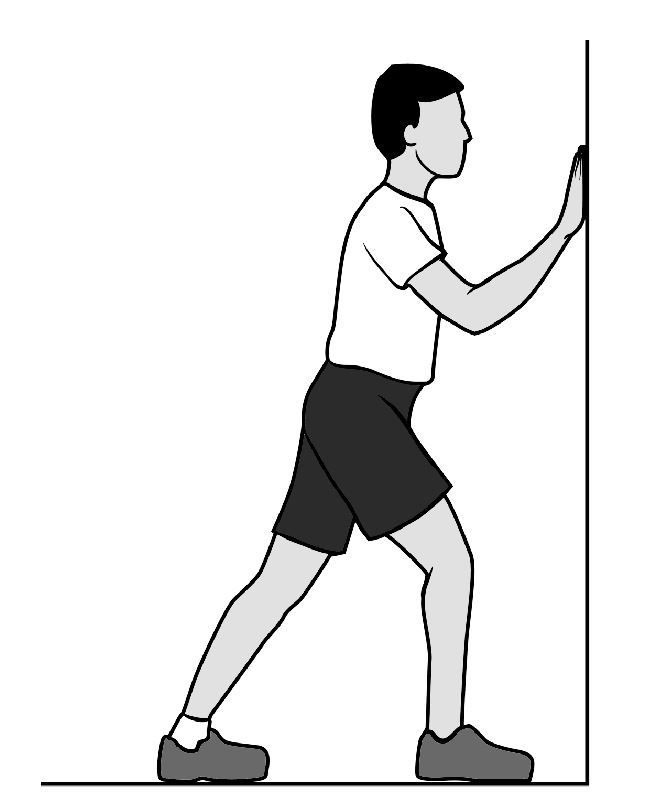
1. Heel Cord Stretch
Main muscles worked: Gastrocnemius-soleus complex
You should feel this stretch in your calf and into your heel
Equipment needed: None
Repetitions 2 sets of 4
Days Per Week 6 to 7
Step-by-step directions
- Stand facing a wall with your unaffected leg forward with a slight bend at the knee. Your affected leg is straight and behind you, with the heel flat and the toes pointed in slightly.
- Keep both heels flat on the floor and press your hips forward toward the wall.
- Hold this stretch for 30 seconds and then relax for 30 seconds. Repeat.
Tip Do not arch your back.
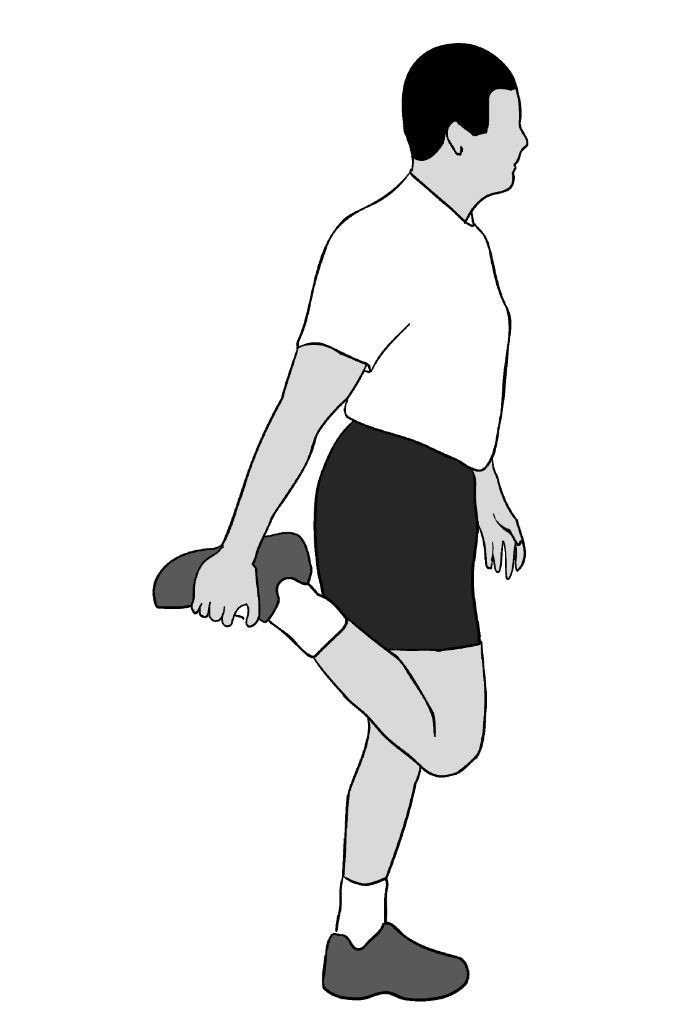
2. Standing Quadriceps Stretch
Main muscles worked: Quadriceps
You should feel this stretch in the front of your thigh
Equipment needed: None
Repetitions 2 to 3
Days Per Week 4 to 5
Step-by-step directions
- Hold on to the back of a chair or a wall for balance.
- Bend your knee and bring your heel up toward your buttock.
- Grasp your ankle with your hand and gently pull your heel closer to your body.
- Hold this position for 30 to 60 seconds.
- Repeat with the opposite leg.
Tip Do not arch or twist your back.
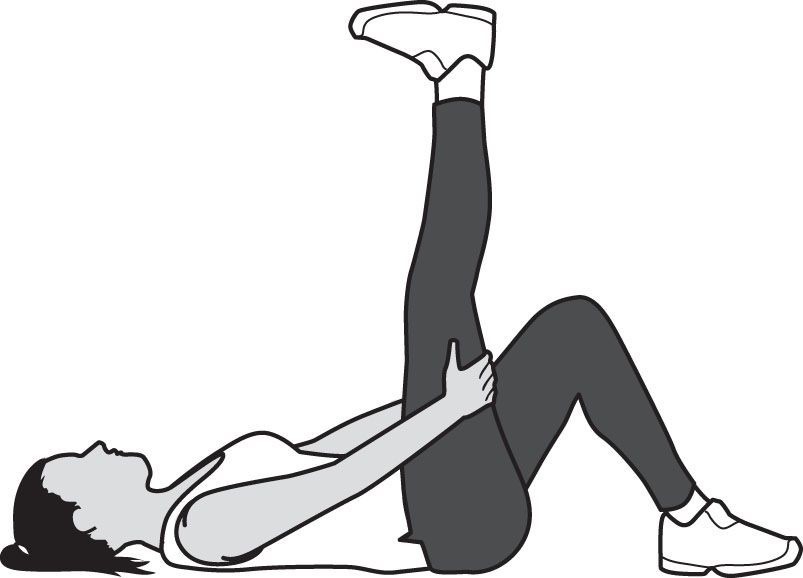
3. Supine Hamstring Stretch
Main muscles worked: Hamstrings
You should feel this stretch at the back of your thigh and behind your knee
Equipment needed: None
Repetitions 2 to 3
Days Per Week 4 to 5
Step-by-step directions
- Lie on the floor with both legs bent.
- Lift one leg off of the floor and bring the knee toward your chest. Clasp your hands behind your thigh below your knee.
- Straighten your leg and then pull it gently toward your head, until you feel a stretch. (If you have difficulty clasping your hands behind your leg, loop a towel around your thigh. Grasp the ends of the towel and pull your leg toward you.)
- Hold this position for 30 to 60 seconds.
- Repeat with the opposite leg.
Tip Do not put your hands at your knee joint and pull.
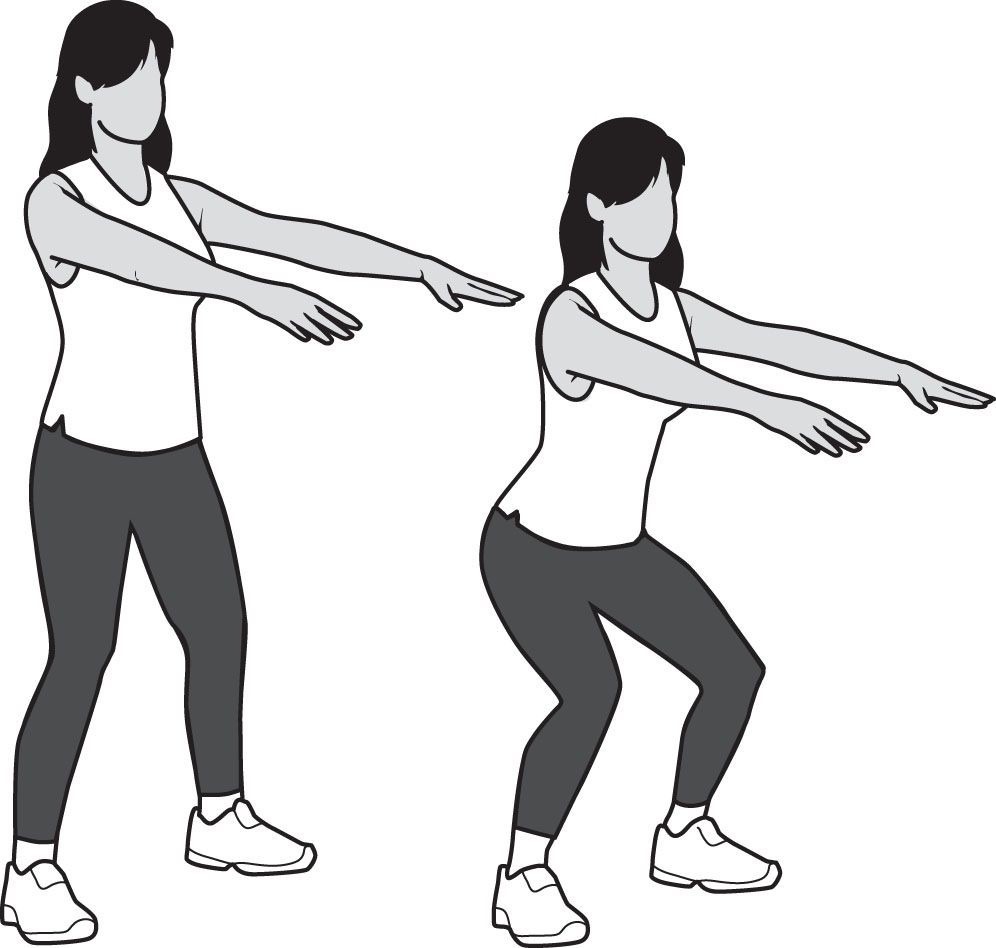
4. Half Squats
Main muscles worked: Quadriceps, gluteus, hamstrings
You should feel this exercise at the front and back of your thighs, and your buttocks
Equipment needed: As the exercise becomes easier to perform, gradually increase the resistance by holding hand weights. Begin with 2 kilos weights and gradually progress to a greater level of resistance, up to 4 killos weights.
Repetitions 3 sets of 10
Days Per Week 4 to 5
Step-by-step directions
- Stand with your feet shoulder distance apart. Your hands can rest on the front of your thighs or reach in front of you. If needed, hold on to the back of a chair or wall for balance.
- Keep your chest lifted and slowly lower your hips about 10 inches, as if you are sitting down into a chair.
- Plant your weight in your heels and hold the squat for 5 seconds.
- Push through your heels and bring your body back up to standing.
Tip Do not bend forward at your waist.
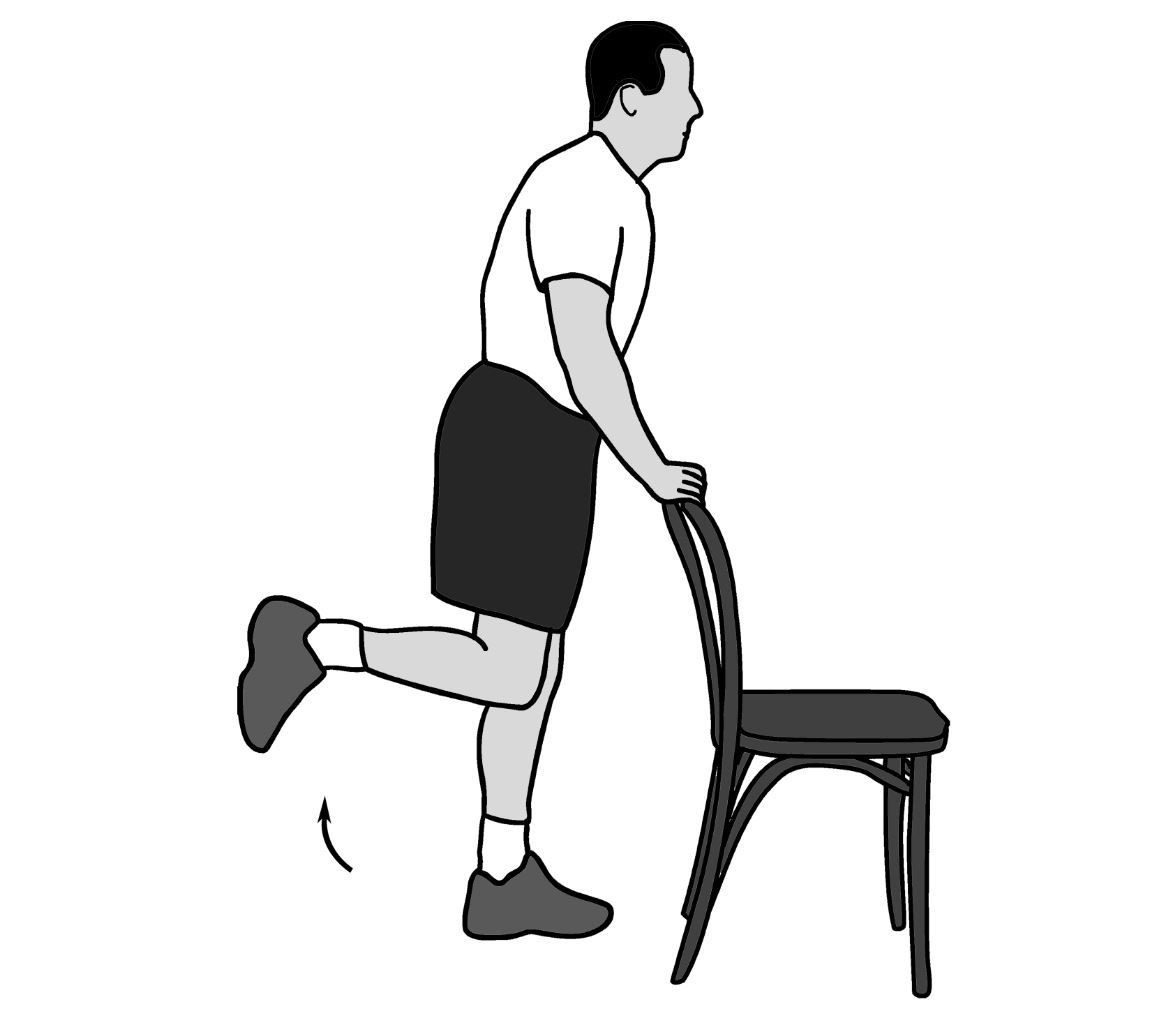
5. Hamstring Curls
Main muscles worked: Hamstrings
You should feel this exercise at the back of your thigh
Equipment needed: As the exercise becomes easier to perform, gradually increase the resistance by adding an ankle weight. Begin with a 2 kilos weight and gradually progress to a greater level of resistance, up to a 4 kilos weight. If you have access to a fitness center, this exercise can also be performed on a weight machine. A fitness assistant at your gym can instruct you on how to use the machines safely.
Repetitions 3 sets of 10
Days Per Week 4 to 5
Step-by-step directions
- Hold onto the back of a chair or a wall for balance.
- Bend your affected knee and raise your heel toward the ceiling as far as possible without pain.
- Hold this position for 5 seconds and then relax. Repeat.
Tip Flex your foot and keep your knees close together.
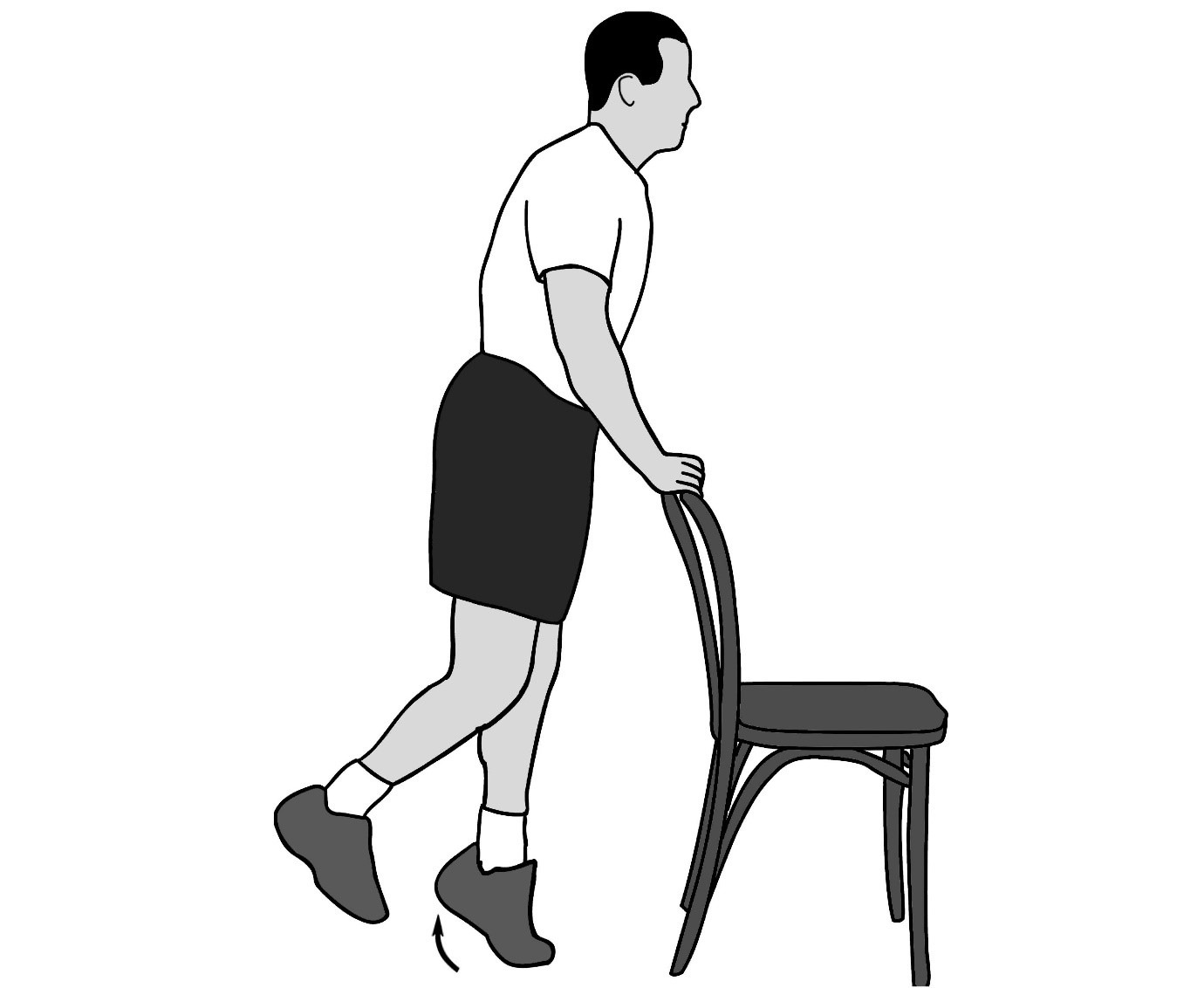
6. Calf Raises
Main muscles worked: Gastrocnemius-soleus complex
You should feel this exercise in your calf
Equipment needed: Chair for support
Repetitions 2 sets of 10
Days Per Week 6 to 7
Step-by-step directions
- Stand with your weight evenly distributed over both feet. Hold onto the back of a chair or a wall for balance.
- Lift your unaffected foot off of the floor so that all of your weight is placed on your affected foot.
- Raise the heel of your affected foot as high as you can, then lower.
- Repeat 10 times.
Tip Keep your weight centered on the ball of your working foot.
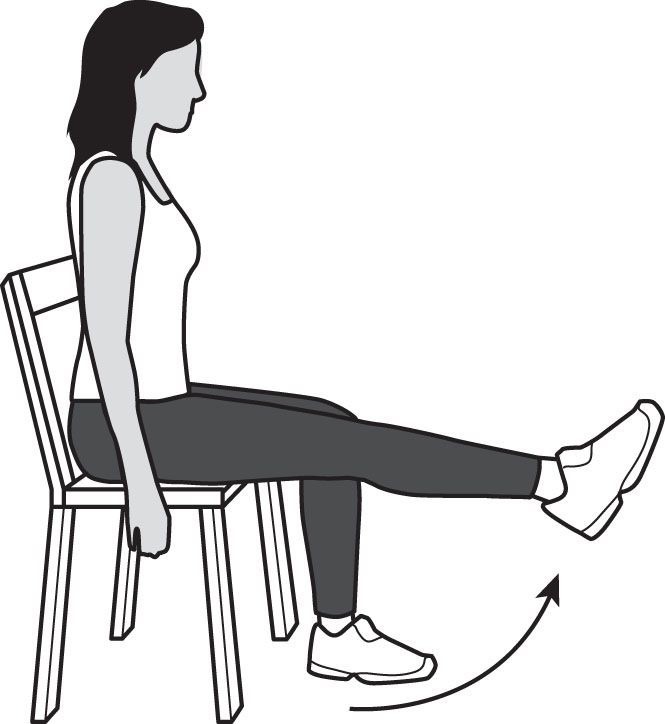
7. Leg Extensions
Main muscles worked: Quadriceps
You should feel this exercise at the front of your thigh
Equipment needed: As the exercise becomes easier to perform, gradually increase the resistance by adding an ankle weight. Begin with a 2 kilos weight and gradually progress to a greater level of resistance, up to a 4 kilos weight. If you have access to a fitness center, this exercise can also be performed on a weight machine. A fitness assistant at your gym can instruct you on how to use the machines safely.
Repetitions 3 sets of 10
Days Per Week 4 to 5
Step-by-step directions
- Sit up straight on a chair or bench.
- Tighten your thigh muscles and slowly straighten and raise your affected leg as high as possible.
- Squeeze your thigh muscles and hold this position for 5 seconds. Relax and bring your foot to the floor. Repeat.
Tip Do not swing your leg or use forceful momentum to lift it higher.
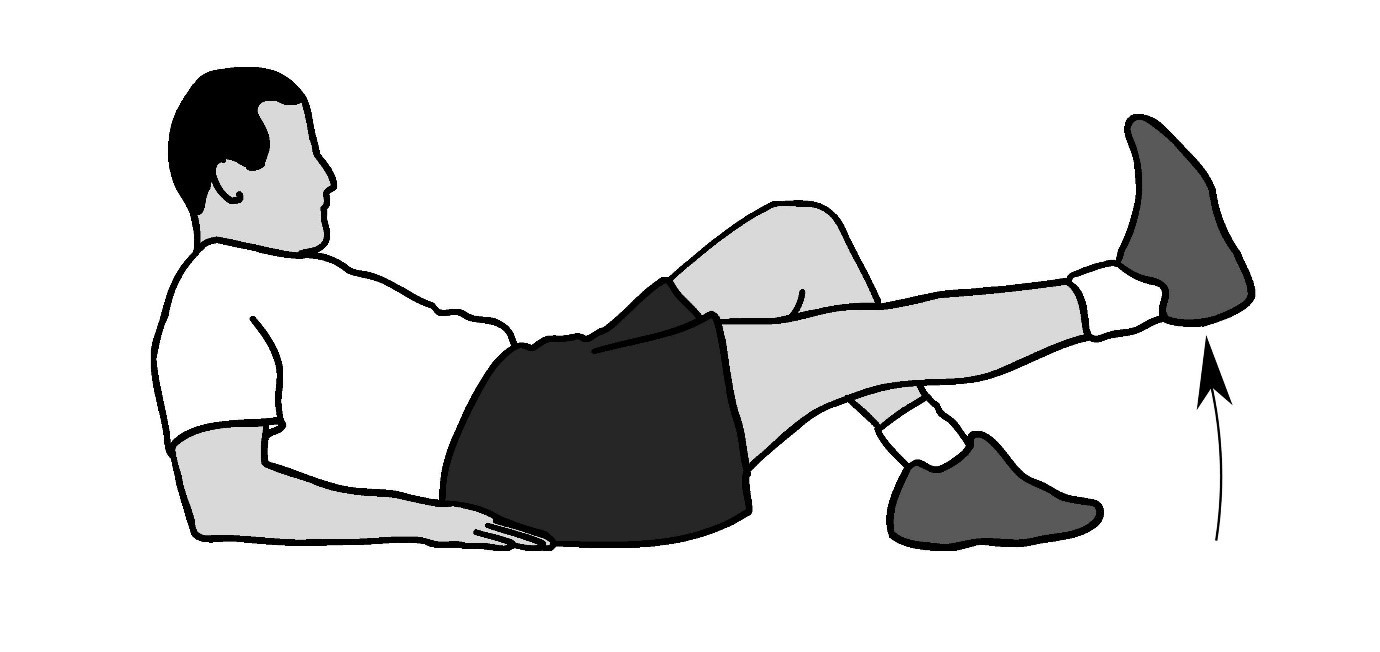
8. Straight-Leg Raises
Main muscles worked: Quadriceps
You should feel this exercise at the front of your thigh
Equipment needed: As the exercise becomes easier to perform, gradually increase the resistance by adding an ankle weight. Begin with a 2 kilos weight and gradually progress to a greater level of resistance, up to a 4 kilos weight. If you have access to a fitness center, this exercise can also be performed on a weight machine. A fitness assistant at your gym can instruct you on how to use the machines safely.
Repetitions 3 sets of 10
Days Per Week 4 to 5
Step-by-step directions
- Lie on the floor with your elbows directly under your shoulders to support your upper body.
- Keep your affected leg straight and bend your other leg so that your foot is flat on the floor.
- Tighten the thigh muscle of your affected leg and slowly raise it 6 to 10 inches off the floor.
- Hold this position for 5 seconds and then relax and bring your leg to the floor. Repeat.
Tip Do not tense up in your neck and shoulders.
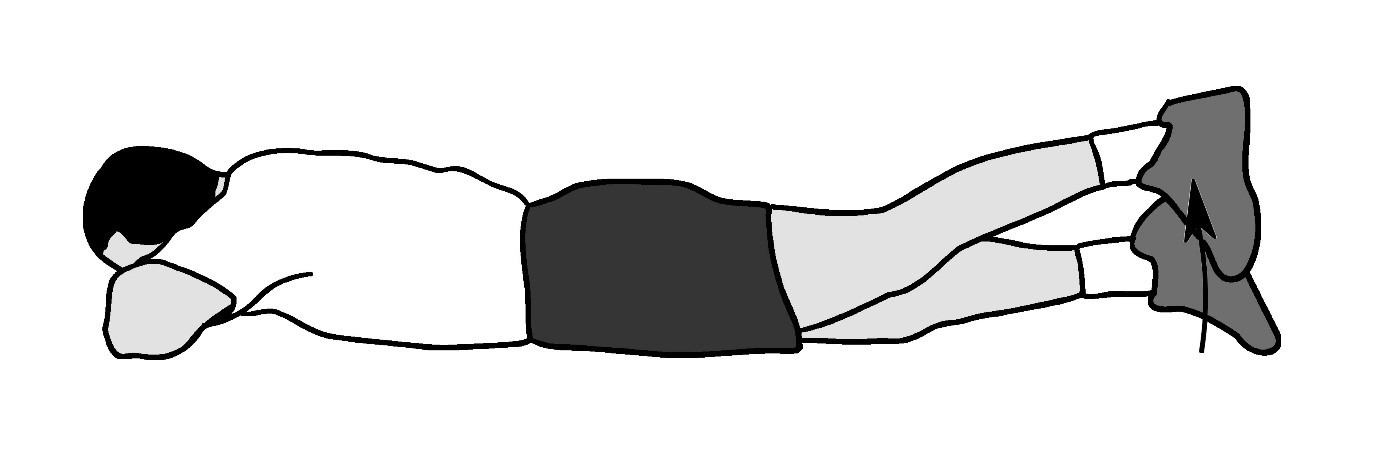
9. Straight-Leg Raises (Prone)
Main muscles worked: Hamstrings, gluteus
You should feel this exercise at the back of your thigh and into your buttock
Equipment needed: As the exercise becomes easier to perform, gradually increase the resistance by adding an ankle weight. Begin with a 2 kilos weight and gradually progress to a greater level of resistance, up to a 4 kilos weight. If you have access to a fitness center, this exercise can also be performed on a weight machine. A fitness assistant at your gym can instruct you on how to use the machines safely.
Repetitions 3 sets of 10
Days Per Week 4 to 5
Step-by-step directions
- Lie on the floor on your stomach with your legs straight. Rest your head on your arms.
- Tighten your gluteus and hamstring muscles of the affected leg and raise the leg toward the ceiling as high as you can.
- Hold this position for 5 seconds.
- Lower your leg and rest it for 2 seconds. Repeat.
Tip Keep your pelvic bones on the floor.
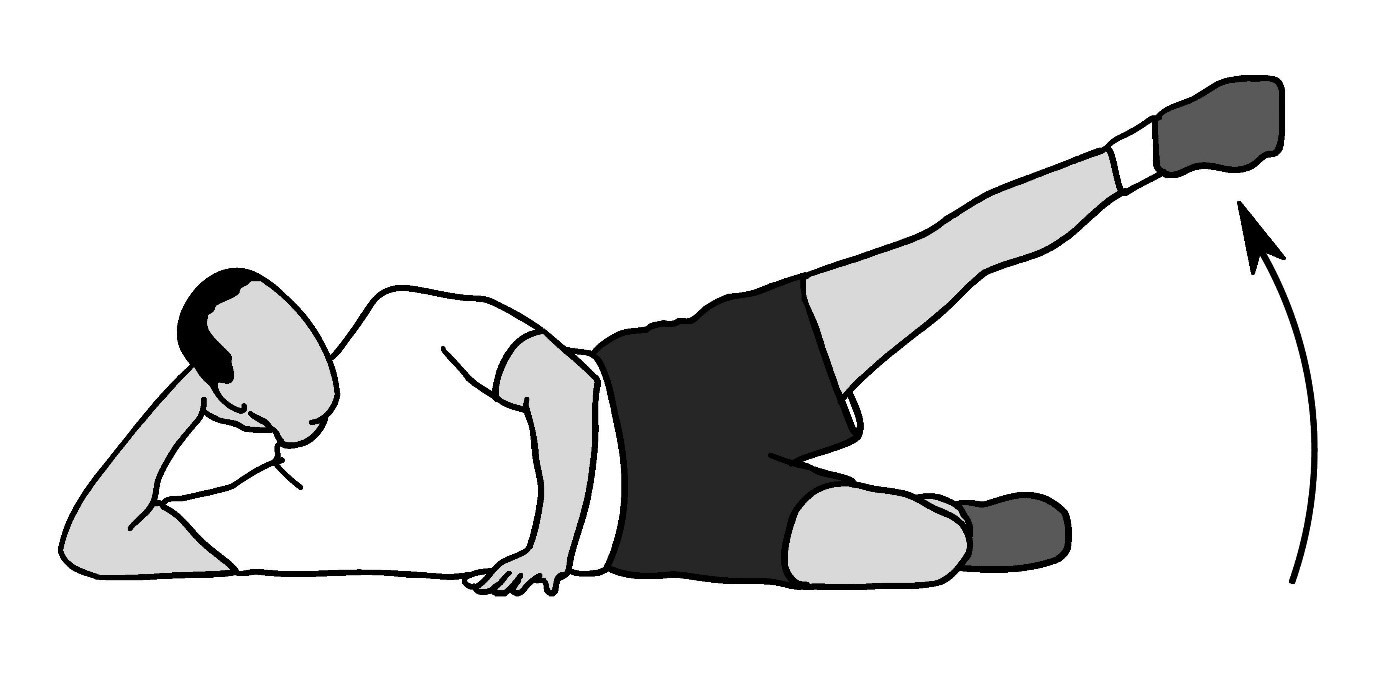
10. Hip Abduction
Main muscles worked: Abductors, gluteus
You should feel this exercise at your outer thigh and buttock
Equipment needed: As the exercise becomes easier to perform, gradually increase the resistance by adding an ankle weight. Begin with a 2 kilos weight and gradually progress to a greater level of resistance, up to a 4 kilos weight.
Repetitions 3 sets of 20
Days Per Week 4 to 5
Step-by-step directions
- Lie on your side with your injured leg on top and the bottom leg bent to provide support.
- Straighten your top leg and slowly raise it to 45°, keeping your knee straight, but not locked.
- Hold this position for 5 seconds.
- Slowly lower your leg and relax it for 2 seconds. Repeat.
Tip Do not rotate your leg in an effort to raise it higher.
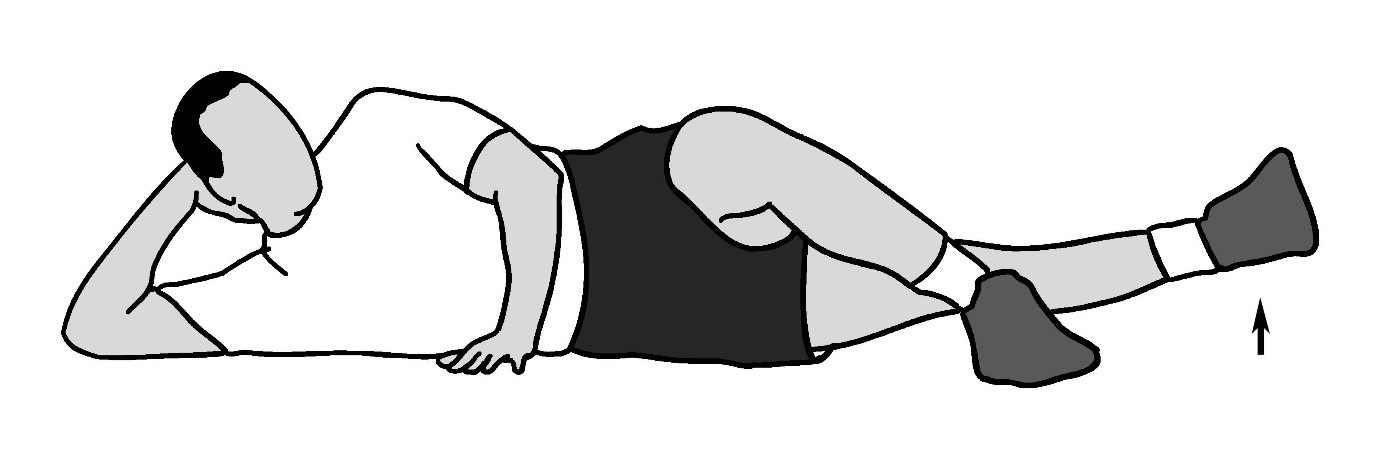
11. Hip Adduction
Main muscles worked: Adductors
You should feel this exercise at your inner thigh
Equipment needed: As the exercise becomes easier to perform, gradually increase the resistance by adding an ankle weight. Begin with a 2 kilos weight and gradually progress to a greater level of resistance, up to a 4 kilos weight.
Repetitions 3 sets of 20
Days Per Week 4 to 5
Step-by-step directions
- Lie down on the floor on the side of your injured leg with both legs straight.
- Cross the uninjured leg in front of the injured leg.
- Raise the injured leg 6 to 8 inches off the floor.
- Hold this position for 5 seconds.
- Lower your leg and rest for 2 seconds. Repeat.
Tip Place your hand on the floor in front of your stomach for support.
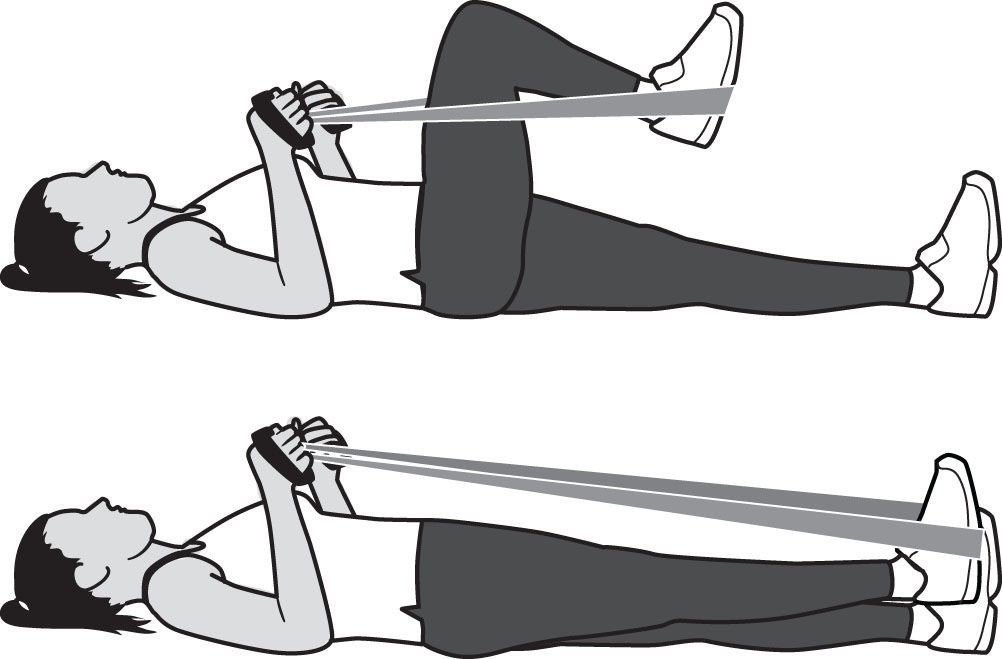
12. Leg Presses
Main muscles worked: Quadriceps, hamstrings
You should feel this exercise at the front of your hip, and the front and back of your thigh
Equipment needed: This exercise is best performed using an elastic stretch band of comfortable resistance. As the exercise becomes easier to perform, gradually increase the level of resistance. Do not use ankle weights with this exercise. If you have access to a fitness center, this exercise can also be performed on a weight machine. A fitness assistant at your gym can instruct you on how to use the machines safely.
Repetitions 3 sets of 10
Days Per Week 4 to 5
Step-by-step directions
- Place the center of the elastic band at the arch of your foot and hold the ends in each hand. Lie on the floor with your elbows bent.
- Tighten the thigh muscle of your affected leg and bring your knee toward your chest.
- Flex your foot and slowly straighten your leg directly in front of you, pushing against the elastic band.
- Hold this position for 2 seconds. Relax and bring your leg to the floor. Repeat.
Tip Keep your abdominals tight throughout the exercise.
